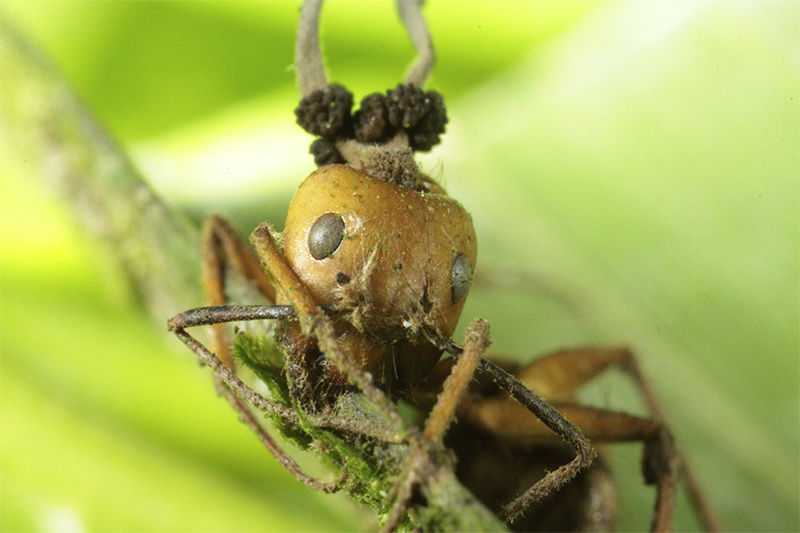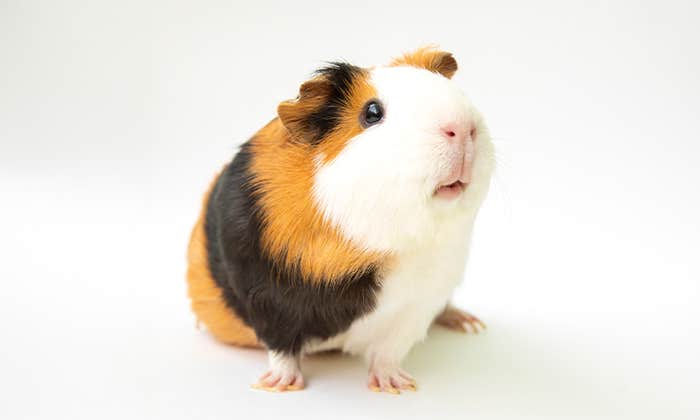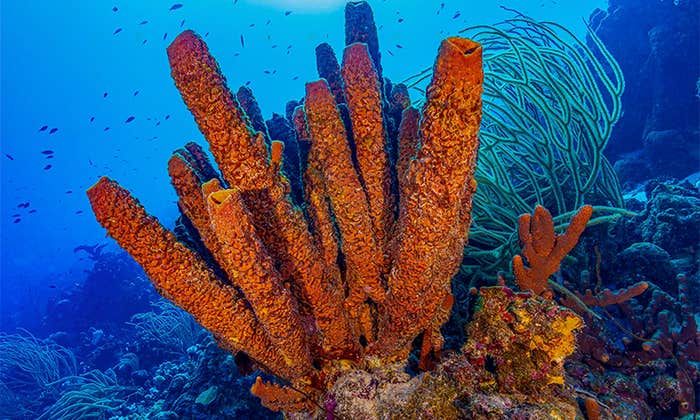What if some outside force could control your mind and make you act against your own interests? It’s a terrifying prospect—one that captures our imagination and recurs frequently in our fiction. It’s the goal of one of the three Unforgivable Curses in Harry Potter. It’s the purpose of Newspeak, the fictional language in George Orwell’s 1984. It enthralls in classics such as Brave New World and The Manchurian Candidate. In the 1950s, the CIA was so concerned that the communists had developed mind-control techniques that they launched their own secret program called MK-ULTRA, whose purpose was to use hallucinogenic drugs and biological manipulation to achieve mind control in ways that could be used against the United States’ enemies. It didn’t work—but mind control is real, and it can be observed in nature. Parasites do it all the time.
Parasites are organisms that live in or on other creatures, feeding on their hosts and taking their resources. They infect animals and pull their behavioral strings, manipulating them like marionettes. Such parasites are “essentially neuroengineers,” as one recent paper puts it, “capable of controlling the central nervous systems of the hosts they infect.”1 Their tactics are astonishing.
Neurochemical mind control is not just the stuff of science fiction.
Consider the fluke parasite Dicrocoelium dendriticum. It masterminds a cycle that starts in the liver of a hoofed animal—a cow or sheep. First, it lays eggs that end up in the animal’s digestive system. When the eggs are pooped out, a snail feeds on them. The parasite’s eggs hatch inside the snail’s intestines. Once the larvae are able, they drill through the snail’s gut into its digestive tract, where they become juveniles. The parasites exit when the snail excretes a ball of slime.
Ants then swallow the slime balls loaded with flukes. The parasite now needs its ant host to be eaten by a hoofed animal to restart the cycle—but this is a problem because hoofed animals eat grass, not ants. The parasite’s solution? Make the ant climb to the tip of a blade of grass and immobilize it there—in the exact location where it has the highest likelihood of being eaten by a grazing cow or sheep. But being in full view of the midday sun might scorch and kill the ant before it has a chance to get eaten. To solve this problem, the parasite makes the ant retreat down the blade of grass when it gets too hot. When the weather cools, D. dendriticum drives the ant back to the top after the risk of death by scorching has passed.
Not all parasites are microbial. Take brood parasites—birds that leave their eggs in other birds’ nests so that these abandoned eggs can be raised by unwitting foster parents. Some brood parasites use mafia-like manipulation strategies: If the host parents reject the foreign egg, the brood parasite will come back and punish the hosts by destroying their entire nest. In one study, researchers experimentally manipulated whether parasite (cowbird) eggs were rejected from host (warbler) nests, and found that cowbird parasites came back and destroyed 56 percent of rejector nests compared to only 6 percent of acceptor nests.2 The point of this parasite strategy is that it incentivizes compliance in the host parents: If the host tolerates one foreign egg, it will be allowed to raise several of its own offspring. If it rejects the foreign egg, it will lose all of its own offspring. The host is therefore pressured into tolerating parasite eggs. Researchers don’t yet know whether regular, non-brood parasites ever use similar “mafia-like” strategies to make their hosts fall in line.

The parasitic flatworm Euhaplorchis californiensis takes a more bizarre approach. Its mission: Infect a fish, hijack the fish’s mind, and coerce it into getting eaten by a bird, where the flatworm can complete its life cycle. The flatworm manipulates the fish into spending more time at the surface of the water—the perfect location for a fish who wants to become bird dinner.3 The parasite also has a second trick up its sleeve: It makes the fish repeatedly roll to the side and display its belly, which gives off a conspicuous silvery glint that catches the attention of predatory birds overhead.
How does E. californiensis do it? It sets up shop in the fish’s brain and alters its neurochemistry.4 Although the exact mechanisms remain to be discovered, evidence shows that the parasite modulates the fish’s levels of dopamine and serotonin—related to arousal and locomotion—inhibiting its natural response to stress. In essence, the parasite encourages the fish to remain mobile and conspicuous, which makes it more likely to get eaten by its predators. Neurochemical mind control is not just the stuff of science fiction. It’s a successful strategy that some parasites have turned into a finely tuned art.
Like E. californiensis, the flatworm Leucochloridium also manipulates its host into getting devoured by predators. This wily flatworm infects snails with artistic flair. To make its host look more like a tasty caterpillar—extra juicy and attractive to birds—the parasite turns the snail’s eye stalks into a throbbing, pulsating dance of color.
Parasites have more than one method of getting their way. Sometimes they manipulate their host into seeking the environment that they need to breed or to release their eggs. When a hairworm parasite infects a cricket, it spurs the cricket to do something shocking: commit suicide by jumping into water. This kills the cricket but benefits the worm: The parasite can now emerge from its cricket host and begin the next stage of its life cycle, which involves finding a mate and releasing its parasite eggs into the water. If you think this sounds too bizarre to be real, trust me, I’m sympathetic. But the evidence shows that this strategy—driving one’s host to a watery suicide—is so effective that it has evolved more than once among different lineages of parasites.
Parasitic fungi have a similar trick. Their manipulation doesn’t involve water, but it is equally dramatic. The fungus forces its infected ant host to climb to an elevated branch on a tree so that the ant can die where conditions are better for the parasite. From the parasite’s perspective, an elevated branch is the perfect vantage point from which to rain down fungal spores onto new hosts.
To appreciate how sophisticated this tactic is, it helps to know that ants are masters at stopping the spread of infectious disease. They quarantine diseased members of their group, and when a nestmate dies, they quickly remove the cadaver from the nest. By forcing infected ants to leave the nest and die elsewhere, the fungus manages to circumvent the ants’ quarantining practices. Because the infected ant dies outside home base, it becomes impossible for its nestmates to safely dispose of its corpse. Amazingly, this tactic—manipulating hosts into deserting their colony so they can die in a location that better suits the parasites’ needs—is so successful that it has evolved at least four times independently among living organisms.
Parasites outperform our most cutting-edge neuroscience when it comes to behavioral manipulation.
“There is something both unnerving and entrancing in the spectacle of an animal moving against its instinct to the drumbeat of a parasite inside its body,” write neuroethologist Frederic Libersat and his co-author David Hughes in a 2019 paper in Current Biology.1 “For biologists, the fact that such machinations have evolved repeatedly in the natural world offers us great opportunities to understand the why and how of manipulation and include such impressive adaptations into our framework for understanding evolution by natural selection.” Natural selection: the most marvelous of algorithms.
Another way for parasites to get from host to host is to infect an organism and use it as a vehicle or vector to help the parasite spread. The malaria-causing parasite Plasmodium has mastered this tactic. When it settles in mosquitoes, it interferes with their ability to drink properly. The point of this is that if the mosquito remains thirsty, it will need to draw blood from a greater number of hosts, which enables the parasite to get into more hosts.5
As for us, the parasite impairs our blood’s ability to clot, which helps it pass from our bloodstream into mosquitoes. Some studies suggest that the malaria parasite may even make infected people smell more attractive to mosquitoes. If true, it wouldn’t be the only species to do something like this: The parasite that causes Leishmaniasis, a tropical disease that can cause skin sores, alters the odor of its hosts, and the virus that causes Dengue fever manipulates genes in the mosquito’s antenna that affect its olfactory receptors, improving the mosquito’s sense of smell.6 Parasites may be small and invisible to the naked eye, but they are powerful manipulators.
Another parasitic route is a favorite among wasps: Spend some time maturing inside your host, emerge when you’re ready, lay your eggs nearby, then manipulate the host into taking care of you and your offspring.7 Parasitoid wasps use this classic strategy, or a variant of it, with their spider and caterpillar hosts. In some cases, the wasp makes its host act like a bodyguard. A 2008 study finds that after the wasp larvae leave the host to pupate, “the host stops feeding, remains close to the pupae, knocks off predators with violent head-swings, and dies before reaching adulthood.”8
In other cases, the wasp turns its host into a zombie construction worker. The hijacked spider or caterpillar works hard to weave a web or a cocoon that protects the wasp and its offspring rather than the host—only to be killed as soon as it’s done weaving! In a 2000 study published in Nature, behavioral ecologist William Eberhard shows “the mechanism employed by the larva to manipulate the spider’s behavior is fast-acting, apparently chemical, and has long-term effects.”9
An important caveat: When infected hosts engage in weird behavior, it isn’t always due to parasitic manipulation. Consider a host that gets infected and then moves to a new microhabitat. This could be manipulation: The parasite might need the new habitat to enter its next life stage, as with the hairworm that emerges from the cricket in water. However, infected hosts often seek hotter microhabitats in order to kill the parasites infecting them.10 To kill foreign invaders, warm-blooded animals will often run a fever, whereas cold-blooded animals use external heat sources to raise their body temperature—by seeking a hot rock in the sun, for example. Both strategies successfully kill parasites.11
The upshot is that when infected hosts behave strangely, we can’t automatically infer parasitic manipulation. Weird post-infection behavior could be one of three things: parasitic manipulation, a simple byproduct of illness, or an adaptive host response to infection, as in the fever example above.7 Because all three possibilities are real, biologists try to be as careful as possible when disentangling the alternative interpretations.
It’s pretty clear, though, that the jewel wasp Ampulex compressa is achieving mind control with the little act of neurosurgery it perpetrates on its cockroach victim. The wasp locates a specific region of its cockroach host’s brain and injects it with a neurochemical cocktail that seems crafted for a specific purpose. The wasp’s precise injection doesn’t paralyze the roach, but it does rob it of its will to escape—a distinction crucial to the parasite’s success.12 If the roach were paralyzed, it would be too big for the wasp to drag. Because the roach is not paralyzed, the tiny wasp is able to drag it, and the victim moves along helpfully like a trained animal on a leash. In this way, the wasp takes the zombie roach to its den, lays an egg on its victim, and buries it alive. Throughout this entire macabre process, the roach shows no interest in escaping. By using neurosurgery to rob the roach of its will to escape—but refraining from physically paralyzing it—the wasp has crafted the exact solution it needs.
The solution is so precise it’s shocking. But maybe it shouldn’t surprise us that parasites outperform our most cutting-edge neuroscience when it comes to behavioral manipulation. After all, evolution has given them a millions-of-years-long head start. ![]()
Laith Al-Shawaf is an associate professor of psychology at the University of Colorado in Colorado Springs. Follow him on Twitter @LaithAlShawaf.
Lead image: Rvector / Shutterstock
References
1. Hughes, D.P. & Libersat, F. Parasite manipulation of host behavior. Current Biology 29, R45-R47 (2019).
2. Hoover, J.P. & Robinson, S.K. Retaliatory mafia behavior by a parasitic cowbird favors host acceptance of parasitic eggs. Proceedings of the National Academy of Sciences 104, 4479-4483 (2007).
3. Lafferty, K.D. & Morris, K.A. Altered behavior of parasitized killifish increases susceptibility to predation by bird final hosts. Ecology 77, 1390-1397 (1996).
4. Shaw, J.C., et al. Parasitic manipulation of brain monoamines in California killifish (Fundulus parvipinnis) by the trematode Euhaplorchis californiensis. Proceedings of the Royal Society B 276, 1137-1146 (2009).
5. Lefèvre, T., et al. Chapter 3 Invasion of the Body Snatchers: The diversity and evolution of manipulative strategies in host-parasite interactions. Advances in Parasitology 68, 45-83 (2009).
6. Staniek, M.E. & Hamilton, J.G.C. Odour of domestic dogs infected with Leishmania infantum is attractive to female but not male sand flies: Evidence for parasite manipulation. PLoS Pathogens 17, e1009354 (2021).
7. Poulin, R. Chapter 5 – Parasite manipulation of host behavior: An update and frequently asked questions. Advances in the Study of Behavior 41, 151-186 (2010).
8. Grosman, A.H., et al. Parasitoid increases survival of its pupae by inducing hosts to fight predators. PLoS One 3, e2276 (2008).
9. Eberhard, W.G. Spider manipulation by a wasp larva. Nature 406, 255-256 (2000).
10. Moore, J. The behavior of parasitized animals. BioScience 45, 89-96 (1995).
11. Neese, R.M. & Williams, G.C. Why We Get Sick: The New Science of Darwinian Medicine Vintage Books, New York, NY (1996).
12. Al-Shawaf, L. The why is not the same as the how: Levels of analysis and scientific progress in psychology. Areo (2020).























